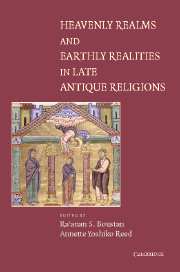Book contents
- Frontmatter
- Contents
- Preface
- List of Contributors
- Introduction: “In Heaven as It Is on Earth”
- PART ONE BETWEEN EARTH AND HEAVEN
- PART TWO INSTITUTIONALIZING HEAVEN
- 6 Earthly Sacrifice and Heavenly Incense: The Law of the Priesthood in Aramaic Levi and Jubilees
- 7 Who's on the Throne? Revelation in the Long Year
- 8 The Earthly Monastery and the Transformation of the Heavenly City in Late Antique Egypt
- 9 Contextualizing Heaven in Third-Century North Africa
- 10 Bringing the Heavenly Academy Down to Earth: Approaches to the Imagery of Divine Pedagogy in the East Syrian Tradition
- PART THREE TRADITION AND INNOVATION
- Select Bibliography
- Index
7 - Who's on the Throne? Revelation in the Long Year
Published online by Cambridge University Press: 14 July 2009
- Frontmatter
- Contents
- Preface
- List of Contributors
- Introduction: “In Heaven as It Is on Earth”
- PART ONE BETWEEN EARTH AND HEAVEN
- PART TWO INSTITUTIONALIZING HEAVEN
- 6 Earthly Sacrifice and Heavenly Incense: The Law of the Priesthood in Aramaic Levi and Jubilees
- 7 Who's on the Throne? Revelation in the Long Year
- 8 The Earthly Monastery and the Transformation of the Heavenly City in Late Antique Egypt
- 9 Contextualizing Heaven in Third-Century North Africa
- 10 Bringing the Heavenly Academy Down to Earth: Approaches to the Imagery of Divine Pedagogy in the East Syrian Tradition
- PART THREE TRADITION AND INNOVATION
- Select Bibliography
- Index
Summary
When Vespasian had “pacified” Galilee and the Judaean environs of Jerusalem – razing villages, enslaving inhabitants and survivors, and killing combatants and the unserviceable elderly – and surrounded the holy city of Jerusalem, word came that Nero had died and that Servius Galba had been raised to the imperial purple. Vespasian sent his son Titus westward to greet the new ruler. But while Titus crossed the isthmus at Corinth on his way to the capitol, news came that Galba had fallen, Otho was now hailed by Senate and people as emperor, and Vitellius was leading the German legions in arms against Otho. Tacitus put Titus's dilemma pithily:
If he should go on to Rome, he would enjoy no gratitude for an act of courtesy intended for another emperor, and he would be a hostage in the hands of either Vitellius or Otho; on the other hand, if he returned to his father, the victor would undoubtedly feel offence; yet, if his father joined the victor's party, while victory was still uncertain, the son would be excused; but, if Vespasian should assume the imperial office, his rivals would be concerned with war and have to forget offences.
(Hist. 2.1)“If … on the other hand … yet … but …”: Titus's need for knowledge outstripped the information available to him through the usual channels of rumor and rumination and, according to Tacitus, Titus sought divine guidance in the sanctuary of Paphian Venus on Cyprus.
- Type
- Chapter
- Information
- Heavenly Realms and Earthly Realities in Late Antique Religions , pp. 123 - 141Publisher: Cambridge University PressPrint publication year: 2004



